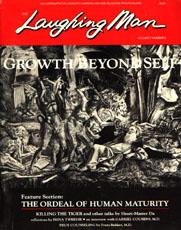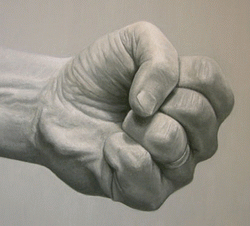
Originally published
in
Laughing Man Magazine – Vol 7 No 2, 1987
Observe
the Self in Toto
A talk by Heart-Master
Da
May 20, 1987
The Listening and Hearing Process
HEART-MASTER DA: The first stage of the listening process is self-observation,1 which is served by the sadhana of study, by response to the Word of the Teacher. There is no way of knowing how long this process will take to become fundamental insight, or “hearing”. All the details of the self must be observed over time. You must observe yourself as a persona, as an actor, as a collection of strategies, in every detail relative to money, food, and sex, and you must also observe your conventional religiosity. This process is served not only by study of the Wisdom-Teaching, but also by study of the Great Tradition,2 using the Wisdom Teaching as the basis for discriminative consideration. At some point, you take on a variety of disciplines to support the process of self-observation. You also in to use the Great Questions, allowing yourself to be pondered by those Questions.
The process of self-observation becomes fundamental understanding of the action that is the conditional self. The self is observed not only in its details but in toto, totally, as the avoidance of relationship, or as self-contraction. This is summary insight, the culmination of the first step in the listening process. Once the self is understood as self-contraction, or the avoidance of relationship, then the advanced form of the listening process is initiated.
In the first stage of the listening process the Great Questions, particularly the two primary ones,3 have something of the significance of the disciplines in general. They are instruments of self-observation. They serve to reflect you to yourself. However, when insight becomes summary, when you have truly observed and understood the search as self contraction, as a motivation that always expresses the avoidance of relationship, then the Great Questions assume a different function. In the advanced form of the listening process the Great Questions become agents, instruments, of the summary insight that you already enjoy. The voice of the Question, then, has become your owe. It is the voice of the Teacher, but it has also become,your own true voice, by virtue of your self-understanding. In a fundamental sense, you have become one with the Teacher, one with the Teaching Word. Then the Great Questions become the -expression of your insight enforcing itself, bringing itself into the present moment, wherein all the ordinary actions of the ego are taking place.
The Way of the Heart is not turning in upon the self to realize an abstract, eternal, internal state. It is not going within and beyond all the forms of the self to find the ultimate soul-level that is free. It is not intellectually observing the self and seeing all its objects and its peripheral signs, and identifying with a consciousness behind that. The process of the Way of the Heart is a process of observing the self totally in the context of every moment.

When the self is observed and understood as self-contraction, then the self-contraction may be felt beyond. Instead of the avoidance of relationship, natural, native, inherent relatedness is realized. When you feel beyond the self-contraction into the simple condition of relatedness, the knot, the pain, of self-contraction is released. If you do not realize you are tightening your fist so hard that you feel pain, you will be motivated by that pain to take a variety of actions, but you will not successfully relieve yourself of the pain. Only when you realize that you are tightening your fist and causing yourself pain can you relax your hand. When you relax, allowing the hand to rest in its natural state, the pain is relieved. The process is basically as simple as that. The self contraction must first be observed in its parts and then totally, as a summary observation, and then it must be felt beyond.
The second or mature phase of the listening and hearing process is the process of feeling beyond the self-contraction, of feeling the native state of unqualified relatedness. The body-mind is not wholly independent but is a totally dependent form, with infinite associations. By reaction, the self presumes itself to be independent or separate and struggles to realize self-sufficiency, non-dependency. In doing so it generates stress, the pain of its own individuation or separation.
The pain of the stressful “knot” is suffered, and the self becomes active in a variety of relationships and experiences in an attempt to relieve the stress. The self does not in that process, however, release the fault. It is looking to compensate for it, to console itself by associations, as if the solution were elsewhere, whereas, in fact, the problem is with the self itself, which must relinquish its activity of self-contractiod. You cannot do this from a position outside the self, a peripheral position. You must release the knot from the position of the knot. You cannot merely sense a pain in your stomach, relate mentally to the knot and the general sense of yourself, and release the knot. You must stand in the very position in which the knot is being generated, before it is expressed as a knot in the solar plexus or any other place of disturbance in the body-mind. The ability to stand in the position in which the self-contraction is generated is served in the initial phase of the listening process. Detailed self-observation, to the point of fundamental insight, is the process whereby you come to stand in the position of the self contraction, the original place where the pain that is motivating the search is generated.
Thereafter, every moment of self-enquiry,4 “Avoiding relationship?”, addresses the present moment of existence,,, observes the pain, and understands the. self-contraction. This understanding allows the simple gesture of release, allows you to stand prior to self contraction. When you stand in the position of the knot itself, the position of creating it, you can then feel beyond it and simply stand in the natural condition of relatedness. Thus, in any moment in which this simple feeling-realization is re-awakened whole-bodily, the knot of egoity is released, and you stand in the position of equanimity.
This realization, this original insight is twofold. First the knot of the self is released, and you are established in prior equanimity. When you stand prior to self-contraction, the disposition of merely being, feeling toward, feeling through, and feeling beyond, is awakened. The free, feeling disposition of free energy and attention, the natural state of equanimity, is realized. The second aspect of the same realization is that you are restored to relatedness. In the context of the first three stages of life, then, this self-understanding restores you to the variety of relations that pertain to the grosser dimension of the body mind. The process must proceed through the advancing stages of life, where this same self-observation, self-understanding, and self enquiry awaken in relation to the limitations that belong to the subtler dimensions of the self-experience.
Thus, the process that leads through the stages begins with listening and hearing. You practice in the sphere of relations and experiences, and you realize fundamental equanimity and relatedness. You progressively observe, understand, and feel beyond the limitations of the stages of life. This process culminates in the sixth stage process or in the transition to the seventh stage of life in the event of transcendence of the feeling of relatedness itself. In that event, the process is made single.
In the earlier stages the process is associated with the feeling of relatedness and therefore with a variety of objects, according to the stage of life. Thus, the agent of the process leading to the seventh stage of life is the feeling of relatedness, which is a natural realization developed on the basis of listening and hearing. In the equanimity prior to self contraction, the feeling of relatedness is wholly felt, wholly allowed, and in any moment in which the self-contraction intervenes, it is observed, understood, and felt beyond, or felt prior to. Instead of self-contraction generating your experience, the -feeling of relatedness, simple being, feeling toward, feeling through, and feeling beyond, is awakened in every moment of true self-enquiry or True Prayer.5
In the transition to the seventh stage of life, the feeling of relatedness itself is transcended. The inherent Condition, the Condition of conditions, Where you Stand, is Realized. Thereafter, even all apparent objects are Recognized as simply the Self, the same Condition that is Self-Radiant Consciousness. Consciousness Itself is the Feeling of Being, without center, without bounds, without limits. It is the Very Divine. Its own Radiance is the Substance of conditional appearances. It is the
Substance of all objects. In the context of the seventh stage of life all objects are Recognized, and in Truth there are no objects. There is only Self-Radiant Being, the Divine Condition Itself. Although apparently there are also objects, there are no objects’ as they appear from the point of view of the ego. The difference is most profound, and, in fact, absolute.
1. Heart-Master Da distinguishes self-observation from mere self-watching, or accumulation of data about the self. In “I” Is the Body of Life (p. 121), he says, “Self-observation is that insight whereby what you might otherwise watch, or notice in yourself, is undone. It cannot occur as a ‘method.’ True self-observation is not a matter of putting yourself forward in a witnessing point of view to see the things that are arising. Self-observation occurs when you are not present as a self, watching.”
2. The “Great Tradition” is Heart-Master Da’s term for mankind’s inheritance of authentic religious, spiritual, magical, and transcendental paths, philosophies, and testimonies from all the eras and cultures of humanity.
3. “Avoiding Relationship?” and “What Is it?” are the principal Questions to be engaged by the listener. See Chapter Nineteen of The Dawn Horse Testament for Heart-Master Da’s discussion of these Questions.
4. The self-enquiry “Avoiding relationship?” is the original form of meditation that Heart-Master Da spontaneously discovered and practiced, to the point of perfect Enlightenment, during his own years of spiritual experimentation and Re-Awakening. It is practiced by individuals in the beginning or, “listening” stage, and some may continue self-enquiry throughout the course of their practice.
5. Heart-Master Da has described True Prayer as selftranscending Communion with God rather than the habit of pleading with God as if God were the Great Parent or the Great Other. In the Way of the Heart True Prayer takes a different form at each of the devotee stages of practice. See The Dawn Horse Testament for Heart-Master Da’s instructions on True Prayer.
What Am I Always Doing?
Avoiding Relationship?
Who or What Is Always The Case (Before “I” Do anything At All)? or Where Is The Inherent Feeling Of Being, or Existence Itself?
Am “I” the One Who Is Living (Animating or Manifesting) me (the body mind) Now?
Who Is Living me Now?
How Do “I” Relate To The One Who Lives me?
Do “I” know What any one or any thing Is? or (In Relation To any particular being, thing, condition, or event that arises) What Is it?
Who, What, and Where Is ‘Adi Da”, Inherent Love-Bliss, or Happiness Itself?
Who, What, and Where Is Consciousness Itself?
What Will “I” Do If “I” Love The Divine Person (The Self-Radiant Being, Happiness Itself, or Consciousness Itself)?